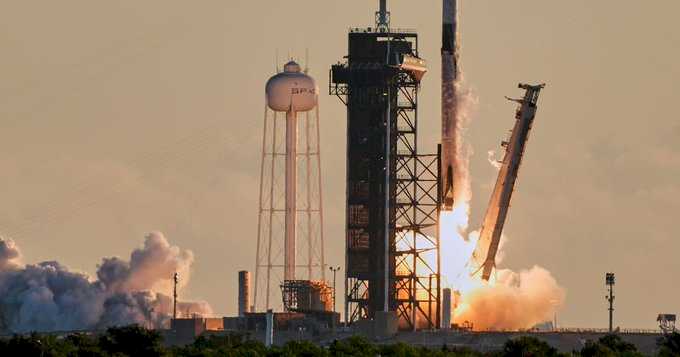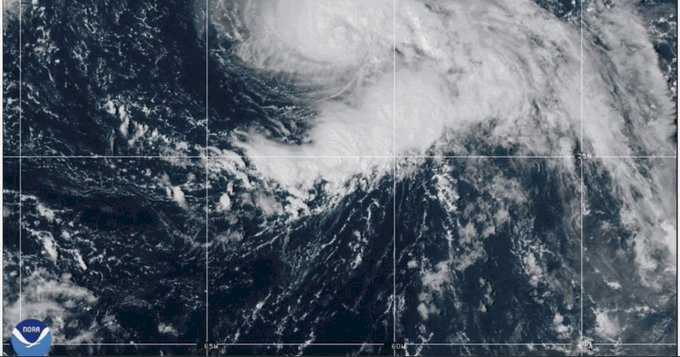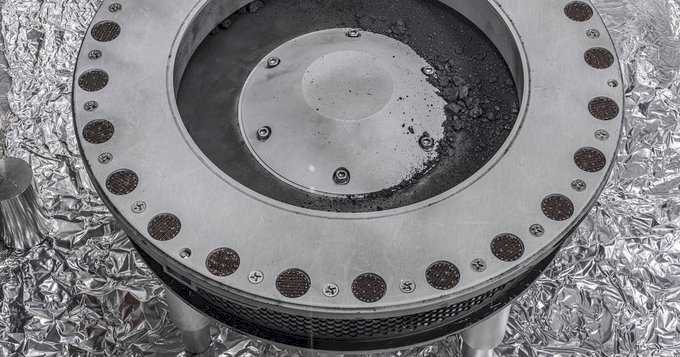A trio of space weather satellites blast off together to study the sun’s violent side

A trio of space weather satellites blast off together to study the sun’s violent side

View 349 times
Gabrielle becomes a hurricane in Atlantic waters southeast of Bermuda. The Miami-based National Hurricane Center said Gabrielle became a Category 1 hurricane after its top sustained winds rose to 75 mph (120 kph). Gabrielle was centered some 320 miles (515 kilometres) southeast of Bermuda and was moving to the north-northwest at 10 mph (17 kph).
The hurricane center said Gabrielle could become a major hurricane in the early part of this week as it is expected to undergo steady to rapid intensification over the next day or so. On the current forecast track, Gabrielle was expected to pass east of Bermuda on Monday.
A hurricane hunter aircraft found the storm at hurricane strength and moving on a more north-northwest track. But the center said a more northerly course was expected Monday. No coastal watches or warnings are in effect, but meteorologists urged interests in Bermuda to keep close watch.
Large ocean swells kicked up by Gabrielle are impacting Bermuda and are expected to reach the Eastern Seaboard from North Carolina northward into Atlantic Canada over the coming days.
In the Pacific, Narda emerged well offshore of Mexico on Sunday afternoon and posed no threat to land.
The hurricane center said Narda had top sustained winds of about 40 mph (65 kph) and was positioned about 240 miles (386 kilometres) south-southeast of Zihuatanejo, Mexico, while moving to the northwest at 10 mph (17 kph). The center says Narda could become a hurricane while heading further offshore.

View 361 times
What to know about this weekend’s total eclipse blood moon,
A spectacular lunar event will take place this weekend, but it unfortunately won’t be visible from Canada.
Between Sept. 7 and Sept. 8, a blood moon total lunar eclipse will be underway during daytime hours in Canada. It will be best viewed from certain parts of China, Russia, India and Australia.
Dr. Ilana MacDonald is the public outreach, communications, and events strategist at the Dunlap Institute for Astronomy & Astrophysics at the University of Toronto. She told CTVNews.ca in a phone interview Thursday that a lunar eclipse happens when the Earth’s shadow covers up the full moon.
“The Earth is going between the sun and the moon, and the Earth’s shadow is being cast onto the moon,” she said. “You gradually see the moon disappear … like a circular shadow going over the moon’s surface."
The phenomenon resembles a bite missing from the moon, which gradually gets smaller until only a little crescent is left.
“Then when the Earth’s shadow completely covers the moon … that’s when you have a total lunar eclipse,” MacDonald says.
Why is it called a Blood Moon?
The blood moon refers to the colour, which MacDonald said comes from sunlight refracting through the edges of the Earth’s atmosphere, scattering onto the moon’s surface.
“Because the Earth’s atmosphere scatters out blue light more than red light, then the surface of the moon tends to have this sort of reddish hue, which can range from a dark orange to a really dark reddish brown,” she says.
There’s a possibility of a lunar eclipse every six month, when tilts of the orbits of the earth and moon perfectly align with the sun.
MacDonald said a lunar eclipse isn’t always visible from the same location because sometimes it’s below the horizon when it’s happening, like this weekend in Canada.
The next lunar eclipse will be in March 2026, but MacDonald said that will be only visible in Northwestern Canada. The one after that will take place on Dec. 31, 2028.

View 440 times
#Lego reveals most expensive set ever .
Lego introduced its most expensive set this week, announcing the release of the Lego Ultimate Collection Series Star Wars Death Star. Priced at US$1,000, or C$1,299.99, the 9,000-plus piece set is Lego’s first-ever item to cost four figures.
The new Death Star set is an intricate piece that’s more than two feet tall and two feet wide. The set, which is not spherical like its earlier Death Star model, but instead is a vertical diorama set, has more than 15 rooms that depict many iconic scenes from the original Star Wars film, “A New Hope,” and “Return of the Jedi,” according to the company’s website.
The set also contains 38 mini figures, including Luke Skywalker, Han Solo, Princess Leia, as well as Galen Erso from “Rogue One” and the Hot Tub Stormtrooper from the Lego Star Wars video games, the company said on its website.
Lego’s previous set that was its most expensive was the Star Wars Millennium Falcon, a 7,541-piece set which broke all records, costing US$800 eight years ago.
This set isn’t the first Death Star to be released by the company, although it is the largest model Lego has ever created. In the last 25 years, Lego has released several models of Star Wars sets in different sizes.
Lego’s World Map is the record holder for having the highest number of pieces, boasting 11,695 .
According to Fortune, roughly 15 per cent of Lego’s sets are marketed for adults.
“Lego bricks have won over adults, growing its $10 billion toy market foothold,” Fortune wrote.
The Lego UCS Star Wars Death Star will officially hit the market Oct. 4
View 414 times
MANCHESTER, United Kingdom — Chinese commercial rocket company #Orienspace has raised tens of millions of dollars in Series B+ financing as it moves towards a key test flight. #spacenews

View 378 times
#Spacedust from asteroid Bennu provides glimpse into celestial past. MONTREAL — #New research on a sample collected from the asteroid Bennu — a small portion of which should arrive in Canada soon — is offering a glimpse into how it came to be.
Studies published in Nature Astronomy and Nature Geoscience last week offer some insight into the granules that were collected and brought to Earth in September 2023 as part of NASA-led OSIRIS-REx mission.
The three studies, which include Canadian scholars, found that Bennu is a near-Earth asteroid, but its composition suggests the parent asteroid it split from contains materials from throughout the solar system.
“What they’ve done is they’ve looked at the origin and the formation and evolution of the Bennu sample to understand its history,” said Dr. Patrick Hill, program scientist at the Canadian Space Agency.
The new research comes as Canada is preparing to receive its own portion for scientific research. Due to its contribution to the mission to retrieve the sample, the Canadian Space Agency will get a cut of the celestial bounty, but no earlier than 2026.
“The CSA is building its capacity to curate its first sample collected in space,” Hill said. Construction of a clean room south of Montreal began in January 2025. The sample would arrive in a carefully co-ordinated transfer with NASA, Hill said.
When it does, it would make Canada the fifth country in the world to curate samples that have been collected in space.
Canada’s will host about four per cent of the total 122 grams of dust and pebbles — just under five grams.
“This area is quite niche because of the astral materials and there’s a lot of requirements that we have to make sure are implemented to ensure that we are not contaminating the sample,” Hill said, which means protecting it from water, organic molecules or plastics.
“The goal of these missions is not to modify the material while it’s here on Earth,” Hill said.
The NASA-led mission launched OSIRIS-REx into space in 2016 to collect from the surface of an asteroid material that scientists hope will offer them insight into the formation of the solar system.
The spacecraft began orbiting the asteroid — called Bennu — in 2018 and grabbed a sample in 2020.
It began a return to Earth in 2021, and a capsule with the rocks and space dust landed in the Utah desert finally arriving in September 2023.
Canada’s contribution to the mission was a laster altimeter tool, known as OLA, which measures altitude and distance. As a result, Bennu was heavily surveyed, with billions of measurements of the asteroid over two years.
The tool helped pinpoint the best place to get a sample, with the craft landing briefly to collect the material.
The most recent studies found that Bennu was formed from a larger parent asteroid destroyed by a collision in the asteroid belt between the orbits of Mars and Jupiter. That parent asteroid formed in the outer solar system with material from a variety of locations including beyond our own solar system.
It was formed from dust from our solar system and organic matter from interstellar space. The analysis of the sample thus far have shown the presence of stardust grains that have compositions that predate the solar system, Hill said.
“We have a lot of meteorites that provide a lot of information about this sort of area of research, but these missions are great because you go and get the sample and you bring it back,” Hill said.
“So it’s not altered by travelling through the atmosphere and modification on the Earth’s surface, so it allows us to really look at the pristine material in detail.”
Another study found that the asteroid was dramatically transformed over time by interactions with water and exposure to the harsh space environment.
This report by The Canadian Press was first published Aug. 31, 2025.
Sidhartha Banerjee, The Canadian Press

View 390 times
#BEIJING, August 26. During a recent working visit to China from August 21 to 26, Science and Higher Education Minister Valery Falkov shared Russia’s aspirations for enhanced scientific collaboration, highlighting the potential for a Chinese experimental station at the Siberian Ring Photon Source (SKIF Collective Use Center). Speaking to TASS, Falkov emphasized the mutual benefits of such partnerships, noting that they enrich the scientific capabilities of both nations.
"We recognize and support the keen interest of our Chinese partners in collaborating on Russia’s megascience infrastructure," Falkov stated. "Such cooperation not only advances our scientific objectives but also fosters shared progress. We anticipate that a Chinese experimental station could be integrated into the SKIF Collective Use Center, which is currently under construction in Koltsovo. Additionally, we have extended invitations for our partners to participate in the International Center for Neutron Research, based on the PIK high-flux reactor in the Leningrad Region, as well as in initiatives to develop a network of modern synchrotron radiation sources, overseen by the Kurchatov Institute National Research Center."
Falkov underscored the importance of expanding China’s role in building international scientific information repositories. "In today’s landscape of scientific discovery, the volume and integration of data directly influence our ability to make new breakthroughs. Enhancing China’s participation in these data-sharing efforts is therefore highly promising."
He also stressed the necessity of coordinated international efforts in big science projects. "Large-scale collaborations are vital for advancing global scientific frontiers. During our visit, we toured several Chinese megascience facilities, including the EAST tokamak. The dedication of Chinese partners to developing cutting-edge scientific technologies, especially in controlled thermonuclear fusion, is truly commendable. The Chinese fusion program received a significant boost when the Kurchatov Institute transferred the Tokamak T-7 facility to China. Today, China stands at the forefront of this field, and I am confident that continued joint efforts will benefit not only our nations but humanity as a whole."
Recalling recent developments, Falkov highlighted a quadripartite protocol signed in May 2023 between Russian and Chinese authorities, the Chinese Academy of Sciences, and the Joint Institute for Nuclear Research. "This agreement outlines priority areas such as joint experiments in heavy ion physics, neutron research, and theoretical physics, alongside work on medical accelerators within the BESIII and JUNO projects, as well as research utilizing the NICA collider in Dubna. Importantly, these agreements are already yielding tangible results - eight scientific projects have been selected and are underway.".
View 360 times
Space news on Umojja.com